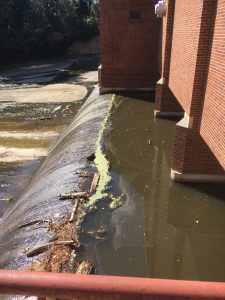We began our tour by walking along the outside of the commons. As we paused and looked out to the lake, we saw the water close to the edge of the lake glazed with a layer of green as a result of algae overgrowth. Most people who pass by this see this as a nuisance, thinking how poorly the school is managing the lake just in time for parents weekend. However, most do not know the full story. The algal blooms are the result of fertilizer runoff from the school’s baseball field and surrounding homeowners that contribute to the Little Westham Creek watershed. The growth is most abundant during last summer and early fall, and the staff shock the river with elemental copper to kill the algae a few times a year. The school also installed bubblers to keep the water moving and aerate the water by introducing oxygen. As student who views the lake as a beautiful focal point of the school, I had given little thought to the contributing polluting factors of the lake and to what extent the school is acting to keep the lake aesthetically pleasing to passer byers.
We moved passed the side of the commons looking out to the lake and walked over to the area behind commons. Since the THC acts as a dam, it is also a fish barrier. As we looked out to where the water drains out of the lake, we saw a multitude of carcasses of dead fish scattered about. Some were on the cusp of death, floundering about on the floor while a heron and a couple of birds glean from the benefits of the barrier. I have never seen the back of THC before, so I was fascinated and a little surprised. This space of lake drainage was tucked away from most of the public, which can be an example of place blindness.
Through student efforts, we looked at how our campus converted from coal to natural gas to reduce carbon dioxide emissions. There are also solar panels installed on top of the Recreation and Wellness center. As the school makes a public effort to become a more eco-friendly campus, there are also hidden drawbacks with new construction such as the parking lot on campus, which can adversely affect the creek’s ecosystem.
This left me wondering: what else does the university do to look appealing for the audience? Are they affecting any other ecosystem besides the Little Westham Creek? This tour opened my eyes to be aware of my surroundings, especially here at the university.

